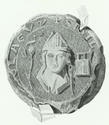 The oldest known musical object from Glasgow was St Kentigern's hand bell. It was worn out with ringing, but the original bell on Glasgow's coat of arms shows a quadrangular Celtic iron bell, some of which still survive. Although the monks sang in Latin, their native language was a form of Welsh. An early local lullaby shows that the child of a wealthy family even had servants for musical entertainment:
"Dinogad's coat is of many colours, many colours. I made it of the skins of pine martens. Phew, phew – a whistling! Let us sing to him – the eight slaves sing to him."
The oldest known musical object from Glasgow was St Kentigern's hand bell. It was worn out with ringing, but the original bell on Glasgow's coat of arms shows a quadrangular Celtic iron bell, some of which still survive. Although the monks sang in Latin, their native language was a form of Welsh. An early local lullaby shows that the child of a wealthy family even had servants for musical entertainment:
"Dinogad's coat is of many colours, many colours. I made it of the skins of pine martens. Phew, phew – a whistling! Let us sing to him – the eight slaves sing to him."
 Kentigern (d. 612) acquired similar status in the Christian hierarchy and readings and beautiful chants recounting his miracles were composed for his feast day and written down in the late 14th century although some may be older.
Kentigern (d. 612) acquired similar status in the Christian hierarchy and readings and beautiful chants recounting his miracles were composed for his feast day and written down in the late 14th century although some may be older.
In the 13th century, Glasgow Cathedral's Precentor, David Bernham (d. 1253), probably had chants in up to three parts performed from a famous music book now in Germany. According to a dedicatory stone, the choral tradition was still strong in the mid-15th century: "These buildings Bishop Andrew caused to be erected for the priests who serve the flourishing choir of Glasgow". In 1480 some choristers' salaries were doubled and the choir would have been able to sing the most complex Scottish polyphony. The city had two "sang schools", one for the collegiate church of St Mary and St Anne, the other for the cathedral which had its own organist, though John Paniter (fl 1520), Maister of the Sang Schule, also deputised. One chorister, Mark Jameson (d. 1592), also kept a garden and seems to have doubled as an abortionist.